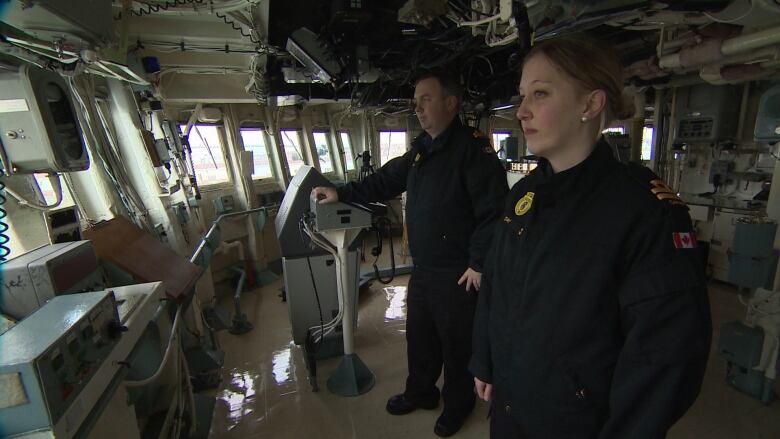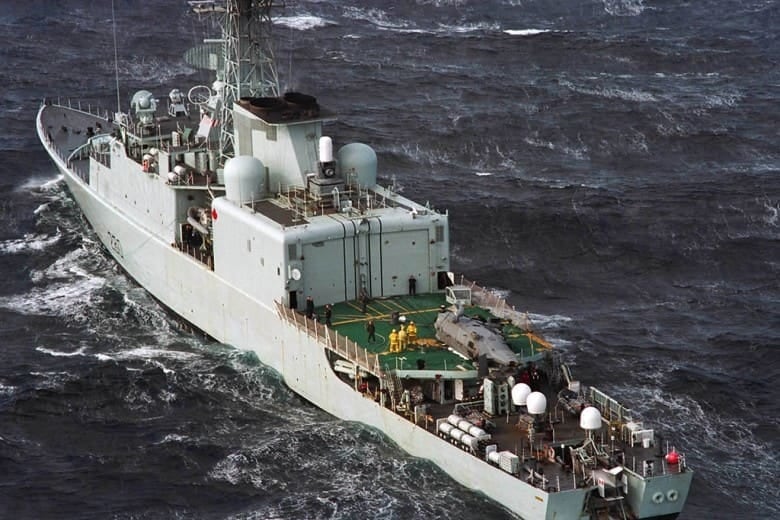HMCS Iroquois decommissioned today after 43 years
Ceremony sad for many former and current crew of Canadian destroyer

The Iroquois was dubbed "a creature of the space age" when the ship slipped into the water from a shipbuilding yard in Sorel, Que., to begin a four-decade career as Canada's flagship destroyer.
Ten years in planning and construction, the Iroquois andthree sister destroyers were designed for a tricky Cold War dual role: a peacetime vessel that could lead rescue missions and fishery patrols, but outfitted with the latest in military slyness and might.
Defence naval architects tested and designed a special hull for anti-submarine warfare that was both fast and quiet. Gas turbines meant the Iroquois could be started and underway in minutes.
- Weddings and baptisms: the second life of HMCS Iroquois
- What it means to pay off or decommission a ship
- 186 baptisms and 860,000 nautical miles: HMCS Iroquois by the numbers
For Able Seaman Maurice Williamson, a marine engineer used to the roughness and mechanical rigours of aging navy ships built for the Second World War, the Iroquois was a marvel.
"We were in awe of this, of the technology," says Williamson, who was part of the first crew whosailed the Iroquois down the St. Lawrence River.

Since its commissioning in 1972, the Iroquois has gone on to sail 860,000 nautical miles the equivalent of nearly 40 times around the globe on countless rescues, exercises, patrols and NATO missions.
But recent years have not been kind. The hull is rusting and last September the military announced it was retiring the destroyer, along with three other Cold War era ships.
'Ships take on a life'
The Iroquois was paid offon Friday in a ceremony at the Halifax Dockyard and decommissioned. It will no longer be called HMCS.
"Ships take on a life, they're alive, too. They have a personality, they're animate," says Larry Murray, a retired vice-admiral who was commander of the Iroquois from 1983 to 1985.
"At the point where you decommission them, somehow they become pieces of metal. And that's kind of tragic."
The ship is the second to be designated HMCS Iroquois. The original was a destroyer that fought during the Second World War and Korean War, but was scrapped in 1966.
Of the four Iroquois-class destroyers built in the 1970s, only the Athabaskan remains on active duty. The Huron was paid off in 2005 and the Algonquin will meet the same fate later this year.
Sailors, current and retired, took one last tour of HMCS Iroquois on Friday. Some will no doubt recall the missions they served on, in the Caribbean, off the coast of Yugoslavia and in the Arabian Sea.
Perilous rescue
One of the most notable is the 1983 rescue from the Ho Ming 5, a Panama freighter listing badly off the coast of Newfoundland. The crew was about to abandon ship in treacherous seas where they would likely die.
Murray was the commander of the Iroquois during the rescue. A Sea King helicopter managed to take off from the pitching deck, rescuing 11 of the Ho Ming crew in gale force winds. Four Iroquois sailors battled 12-metre waves in life-rafts to save nine others.
Six of the crew were awarded the Star of Courage, Canada's second highest award for bravery. Six received the Medal of Bravery, and a further six were awarded the Chief of Defence Staff Commendation.

Murray admits he likely broke the rules by allowing such a perilous rescue in quiet moments he prayed. Ultimately, success came down to a two things: the training and bravery of the crew, and simple good fortune that no one died.
"Ships take on an aura. And Iroquois has always been a lucky ship a happy ship," Murray says.
Future unclear
Murray won't be the only one with nostalgia come Friday. The current crew will no longer be members of the Iroquois, and while some will be needed to maintain systems at a minimum level, many will be disbursed to other duties and postings.
"It'll be different," says Lt. Anne-Marie Day. "We'll have to take off these badges that we've worn for so long and put on another ship's."
Friday, she says, will be a sad day. She will be joined dockside by several generations of crew who feel much the same. Williamson, who retired from the navy in 1982, says he will likely make the drive down from his home in Kentville.
It's not yet clear what will happen to the Iroquois. Williamson hopes the Canadian government will ultimately decide to sink it off the shores of Nova Scotia, much like its sister ship HMCS Huron, which was sunk in 2007 west of Vancouver Island.
"I'd rather see them go that way then sold to scrap," he says. "I'd much rather see her go off Lunenburg."












_(720p).jpg)


 OFFICIAL HD MUSIC VIDEO.jpg)
.jpg)



























































































